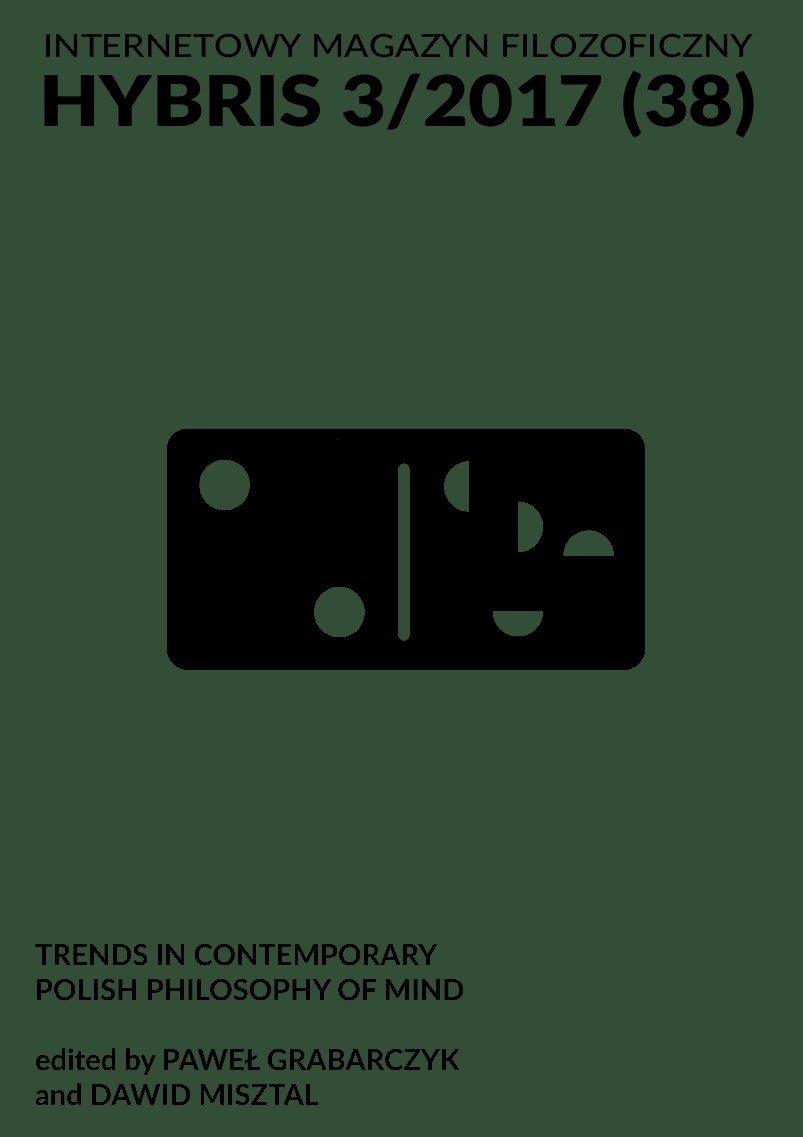Semantic internalism is a mistake
DOI:
https://doi.org/10.18778/1689-4286.38.08Keywords:
internalism, externalism, one-factor dimensional account of representation, mental representation, Fodor, methodological solipsismAbstract
The concept of narrow content is still under discussion in the debate over mental representation. In the paper, one-factor dimensional accounts of representation are analyzed, particularly the case of Fodor's methodological solipsism. In methodological solipsism, semantic properties of content are arguably eliminated in favor of syntactic ones. If “narrow content” means content properties independent of external factors to a system (as in Segal's view), the concept of content becomes elusive. Moreover, important conceptual problems with one-factor dimensional account are pointed out as a result of analysis arguments presented by J. Searle, S. Harnad and T. Burge. Furthermore, these problems are illustrated with psychological and ethological examples. Although understanding content as partially independent from contextual factors allows theorists to preserve content properties, it seems that understanding content in total abstraction from external factors of these properties is implausible. As a result, internalism is rejected in favor of externalism.
References
Block, Ned. 1987. “Advertisement for a Semantics for Psychology.” Midwest Studies in Philosophy 10 (1): 615–78. doi:10.1111/j.1475-4975.1987.tb00558.x.
View in Google Scholar
DOI: https://doi.org/10.1111/j.1475-4975.1987.tb00558.x
Burge, Tyler. 1979. “Individualism and the Mental.” Midwest Studies in Philosophy 4 (1): 73–121. doi:10.1111/j.1475-4975.1979.tb00374.x.
View in Google Scholar
DOI: https://doi.org/10.1111/j.1475-4975.1979.tb00374.x
Carnap, R. 1947. Meaning and Necessity. Chicago: University of Chicago Press.
View in Google Scholar
Chalmers, David J. 1996. The Conscious Mind: In Search of a Fundamental Theory. New York: Oxford University Press.
View in Google Scholar
Chalmers, David J. 2004. “Epistemic Two-Dimensional Semantics.” Philosophical Studies 118 (1/2): 153–226. doi:10.1023/B:PHIL.0000019546.17135.e0.
View in Google Scholar
DOI: https://doi.org/10.1023/B:PHIL.0000019546.17135.e0
Copeland, B. Jack. 1993. Artificial Intelligence: A Philosophical Introduction. Oxford, UK; Cambridge, Mass.: Blackwell.
View in Google Scholar
Copi, Irving, and Carl Cohen. 2002. Introduction to Logic. 11thed. Upper Saddle River N.J.: Prentice Hall.
View in Google Scholar
Dennett, Daniel C. 1987. The Intentional Stance. Cambridge, Mass.: MIT Press.
View in Google Scholar
Dennett, Daniel C. 1991. Consciousness Explained. New York: Back Bay Books / Little Brown and Company.
View in Google Scholar
Field, Hartry. 1978. “Mental Representation.” Erkenntnis 13: 9–61.
View in Google Scholar
DOI: https://doi.org/10.1007/BF00160888
Fodor, Jerry A. 1975. The Language of Thought. 1sted. New York: Thomas Y. Crowell Company.
View in Google Scholar
Fodor, Jerry A. 1980. “Methodological Solipsism Considered as a Research Strategy in Cognitive Psychology.” Behavioral and Brain Sciences 3 (1): 63–63. doi:10.1017/S0140525X00001771.
View in Google Scholar
DOI: https://doi.org/10.1017/S0140525X00001771
Fodor, Jerry A. 1987. Psychosemantics: The Problem of Meaning in the Philosophy of Mind. Cambridge, Mass.: MIT Press.
View in Google Scholar
DOI: https://doi.org/10.7551/mitpress/5684.001.0001
Fodor, Jerry A. 2008. LOT 2: The Language of Thought Revisited. Oxford University Press.
View in Google Scholar
DOI: https://doi.org/10.1093/acprof:oso/9780199548774.001.0001
Fodor, Jerry A., M F Garrett, E C Walker, and C H Parkes. 1980. “Against Definitions.” Cognition 8 (3): 263–367.
View in Google Scholar
DOI: https://doi.org/10.1016/0010-0277(80)90008-6
Griffiths, Paul Edmund. 2002. “What Is Innateness?” The Monist 85 (1).
View in Google Scholar
DOI: https://doi.org/10.5840/monist20028518
Gulick, R. van. 2001. “Reduction, Emergence and Other Recent Options on the Mind/body Problem. A Philosophic Overview.” Journal of Consciousness Studies 8 (9–10): 1–34.
View in Google Scholar
Harnad, Stevan. 1990. “The Symbol Grounding Problem.” Physica D 42: 335–46.
View in Google Scholar
DOI: https://doi.org/10.1016/0167-2789(90)90087-6
Hauser, Larry. 1997. “Searle’s Chinese Box: Debunking the Chinese Room Argument.” Minds and Machines 7 (2): 199–226.
View in Google Scholar
DOI: https://doi.org/10.1023/A:1008255830248
Heath, J. 2015. “Methodological Individualism.” In The Stanford Encyclopedia of Philosophy.
View in Google Scholar
Jadacki, Jacek. 2001. Spór O Granice Języka : Elementy Semiotyki Logicznej I Metodologii. Warszawa: Wydawn. Naukowe Semper.
View in Google Scholar
Maruszewski, Tomasz. 1983. Analiza Procesów Poznawczych Jednostki W Świetle Idealizacyjnej Teorii Nauki. Poznań: Wydawn. Nauk. Uniwersytetu im. A. Mickiewicza.
View in Google Scholar
Pitt, David. 2013. “Mental Representation.” Edited by Edward N Zalta. The Stanford Encyclopedia of Philosophy. http://plato.stanford.edu/archives/fall2013/entries/mental-representation/
View in Google Scholar
Poczobut, Robert. 2007. “Eksternalizm Treści Umysłowej a Superweniencja.” Kognitywistyka I Media W Edukacji2 9 (1): 82–106.
View in Google Scholar
Preston, John, and Mark Bishop. 2002. Views into the Chinese Room: New Essays on Searle and Artificial Intelligence. Oxford; New York: Clarendon Press.
View in Google Scholar
Putnam, Hilary. 1975. “The Meaning of Meaning.” In Philosophical Papers, Vol. II : Mind, Language, and Reality. Cambridge: Cambridge University Press.
View in Google Scholar
DOI: https://doi.org/10.1017/CBO9780511625251
Samuels, Richard. 2002. “Nativism in Cognitive Science.” Mind and Language 17 (3): 233–65. doi:10.1111/1468-0017.00197.
View in Google Scholar
DOI: https://doi.org/10.1111/1468-0017.00197
Samuels, Richard. 2004. “Innateness in Cognitive Science.” Trends in Cognitive Sciences 8 (3): 136–41. doi:10.1016/j.tics.2004.01.010.
View in Google Scholar
DOI: https://doi.org/10.1016/j.tics.2004.01.010
Searle, John R. 1980. “Minds, Brains, and Programs.” Behavioral and Brain Sciences 3 (3): 1–19. doi:10.1017/S0140525X00005756.
View in Google Scholar
DOI: https://doi.org/10.1017/S0140525X00005756
Searle, John R. 1983. Intentionality: An Essay in the Philosophy of Mind. Cambridge / New York: Cambridge University Press.
View in Google Scholar
DOI: https://doi.org/10.1017/CBO9781139173452
Segal, Gabriel. 2000. A Slim Book about Narrow Content. Cambridge Mass.: MIT Press. http://www.worldcat.org/title/slim-book-about-narrow-content/oclc/42771559&referer=brief_results
View in Google Scholar
DOI: https://doi.org/10.7551/mitpress/6275.001.0001
Stich, Stephen P. 1980. “Paying the Price for Methodological Solipsism.” Behavioral and Brain Sciences 3 (1): 97. doi:10.1017/S0140525X00002016.
View in Google Scholar
DOI: https://doi.org/10.1017/S0140525X00002016
Yablo, S. 1999. “Intrinsicness.” Philosophical Topics 26 (1/2): 479–505.
View in Google Scholar
DOI: https://doi.org/10.5840/philtopics1999261/234
Downloads
Published
How to Cite
Issue
Section
License

This work is licensed under a Creative Commons Attribution-NonCommercial-NoDerivatives 4.0 International License.






